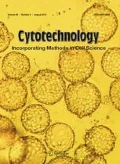Abstract
In recent years, several automated scale-down bioreactor systems have been developed to increase efficiency in cell culture process development. ambr™ is an automated workstation that provides individual monitoring and control of culture dissolved oxygen and pH in single-use, stirred-tank bioreactors at a working volume of 10–15 mL. To evaluate the ambr™ system, we compared the performance of four recombinant Chinese hamster ovary cell lines in a fed-batch process in parallel ambr™, 2-L bench-top bioreactors, and shake flasks. Cultures in ambr™ matched 2-L bioreactors in controlling the environment (temperature, dissolved oxygen, and pH) and in culture performance (growth, viability, glucose, lactate, Na+, osmolality, titer, and product quality). However, cultures in shake flasks did not show comparable performance to the ambr™ and 2-L bioreactors.




Similar content being viewed by others
References
Bareither R, Pollard D (2011) A review of advanced small-scale parallel bioreactor technology for accelerated process development: current state and future need. Biotechnol Prog 27:2–14
Betts JI, Baganz F (2006) Miniature bioreactors: current practices and future opportunities. Microb Cell Fact 5:21
Chisti Y (1993) Animal cell culture in stirred bioreactors: observations on scale-up. Process Biochem 28:511–517
Cohen SA, Michaud DP (1993) Synthesis of a fluorescent derivatizing reagent, 6-aminoquinolyl-N-hydroxysuccinimidyl carbamate, and its application for the analysis of hydrolysate amino acids via high-performance liquid chromatography. Anal Biochem 211:279–287
Cook JA, Fox MH (1988) Effects of chronic pH 6.6 on growth, intracellular pH, and response to 42.0 °C hyperthermia of Chinese Hamster Ovary cells. Cancer Res 48:2417–2420
Gennaro LA, Salas-Solano O (2008) On-line CE-LIF-MS technology for the direct characterization of N-linked glycans from therapeutic antibodies. Anal Chem 80:3838–3845
Guo D, Gao A, Michels DA, Feeney L, Eng M, Chan B, Laird MW, Zhang B, Yu XC, Joly J, Snedecor B, Shen A (2010) Mechanisms of unintended amino acid sequence changes in recombinant monoclonal antibodies expressed in Chinese hamster ovary (CHO) cells. Biotechnol Bioeng 107:163–171
Hopp J, Pritchett R, Darlucio M, Ma J, Chou JH (2009) Development of a high throughput protein a well-plate purification method for monoclonal antibodies. Biotechnol Prog 25:1427–1432
Keane JT, Ryan D, Gray PP (2003) Effect of shear stress on expression of a recombinant protein by Chinese Hamster Ovary cells. Biotechnol Bioeng 81:211–220
Kondragunta B, Drew JL, Brorson KA, Moreira AR, Rao G (2010) Advances in clone selection using high-throughput bioreactors. Biotechnol Prog 26:1095–1103
Kumar S, Wittmann C, Heinzle E (2004) Minibioreactors. Biotechnol Lett 26:1–10
Lewis G, Lugg R, Lee K, Wales R (2010) Novel automated micro-scale bioreactor technology: a qualitative and quantitative mimic for early process development. Bioprocess J 9:22–25
Lin AA, Kimura R, Miller WM (1993) Production of tPA in recombinant CHO cells under oxygen-limited conditions. Biotechnol Bioeng 42:339–350
Restelli V, Wang MD, Huzel N, Ethier M, Perreault H, Butler M (2006) The effect of dissolved oxygen on the production and the glycosylation profile of recombinant human erythropoietin produced from CHO cells. Biotechnol Bioeng 94:481–494
Sauer PW, Burky JE, Wesson MC, Sternard HD, Qu L (2000) A high-yielding, generic fed-batch cell culture process for production of recombinant antibodies. Biotechnol Bioeng 67:585–597
Tissot S, Oberbek A, Reclari M, Dreyer M, Hacker DL, Baldi L, Farhat M, Wurm FM (2011) Efficient and reproducible mammalian cell culture bioprocesses without probes and controllers? N Biotechnol 28:382–390
Trummer E, Fauland K, Seidinger S, Schriebl K, Lattenmayer C, Kunert R, Vorauer-Uhl K, Weik R, Borth N, Katinger H, Muller D (2006) Process parameter shifting: part I. Effect of DOT, pH, and temperature on the performance of Epo-Fc expressing CHO cells cultivated in controlled batch bioreactors. Biotechnol Bioeng 94:1033–1044
Tsao Y-S, Cardoso AG, Condon RGG, Voloch M, Lio P, Lagos JC, Kearns BG, Liu Z (2005) Monitoring Chinese hamster ovary cell culture by the analysis of glucose and lactate metabolism. J Biotechnol 118:316–327
Varley J, Birch J (1999) Reactor design for large scale suspension animal cell culture. Cytotechnology 29:177–205
Yoon SK, Choi SL, Song JY, Lee GM (2005) Effect of culture pH on Erythropoietin production by Chinese Hamster Ovary cells grown in suspension at 32.5 and 37.0 °C. Biotechnol Bioeng 89:345–356
Yuk IH, Baskar D, Duffy PH, Hsiung J, Leung S, Lin AA (2011) Overcoming challenges in WAVE bioreactors without feedback controls for pH and dissolved oxygen. Biotechnol Prog 27:1397–1406
Zhang L, Lilyestrom W, Li C, Scherer T, van Reis R, Zhang B (2011) Revealing a positive charge patch on a recombinant monoclonal antibody by chemical labeling and mass spectrometry. Anal Chem 83:8501–8508
Acknowledgments
The authors thank cell line development groups for generating the CHO cell lines evaluated; B6 media preparation group for supplying all the media and solutions used; cell banking group for supplying ampoules; Peter Harms and Louis Cheung for discussions on methods of higher throughput for off-line analysis; Analytical Operations group, especially Yun Tang, Kevin Lin, and Renee Yang, for providing analytical support for titer, product quality and amino acid assays; Andy Lin and John Joly for guidance and support.
Author information
Authors and Affiliations
Corresponding author
Rights and permissions
About this article
Cite this article
Hsu, WT., Aulakh, R.P.S., Traul, D.L. et al. Advanced microscale bioreactor system: a representative scale-down model for bench-top bioreactors. Cytotechnology 64, 667–678 (2012). https://doi.org/10.1007/s10616-012-9446-1
Received:
Accepted:
Published:
Issue Date:
DOI: https://doi.org/10.1007/s10616-012-9446-1




